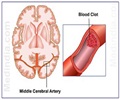Diagnosis
Tests that help to diagnose giant cell arteritis are:
- ESR and C Reactive Protein (CRP) – These tests are higher than in normal individuals. However, they only indicate that the patient has some inflammation but does not confirm temporal arteritis
- Blood counts – Blood counts may show an increase in the number of white blood cells and a decrease in red blood cells
- Liver function tests – Liver enzymes may be raised
- Color duplex sonography – Color duplex sonography is a radiological procedure that helps to visualize the temporal arteries can help to diagnose the condition
- Biopsy – Biopsy of the temporal artery helps to clinch the diagnosis
- Other scans like PET scan and MRI with angiography may also be used to diagnose temporal arteritis
- Eyes should also be examined in detail to rule out complications
A patient is diagnosed as suffering from
- The patient is more than 50 years old
- The patient suffers from a headache that has begun recently or he/she complains of a pain localized to a part of the head
- When the doctor touches the head over the temporal artery, the patient feels pain and the doctor may find that the force of the pulse is reduced
- A blood test called Erythrocyte Sedimentation Rate or ESR is more than 50 mm/h indicating inflammation
- A biopsy taken of the temporal artery is abnormal with inflammation











